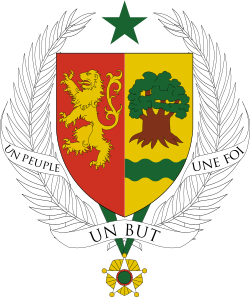Coat of arms of Senegal
| Coat of arms of Senegal | |
|---|---|
 |
|
| Details | |
| Armiger | Republic of Senegal |
| Adopted | 1965 |
| Crest | Green star |
| Escutcheon | Per pale, the first Gules a lion rampant Or, the second Or, a baobab-tree proper and in base a fess wavy Vert |
| Supporters | Palm leaves |
| Motto |
Un Peuple, Un But, Une Foi "One Nation , One Goal, One Faith" |
| Orders | Star of the Ordre National du Lion |
The coat of arms of Senegal is the heraldic device consisting of a shield charged with a lion on the left half and a baobab tree on the right, flanked by palm branches and topped with a five-pointed green star at the top.
Adopted five years after Senegal gained independence, it has been the coat of arms of the Republic of Senegal since 1965. Both symbols on the shield had featured previously on earlier Senegalese emblems.
Senegal gained independence on 20 August 1960, when it separated from the Mali Federation and became an independent country on its own. It took approximately five years to before Senegal adopted its own coat of arms. It was designed by Suzanne Gauthier, a French heraldist from Paris, in 1965. It incorporated the lion and the baobab tree - both symbols were previously utilised on earlier Senegalese emblems.
The colours and objects on the coat of arms carry cultural, political, and regional meanings. The green star at the crest is identical to the one on Senegal's flag. It alludes to Islam, the religion practiced by 94% of Senegal's population.
The dexter (i.e. proper right) of the escutcheon features a lion. A national symbol of Senegal, it stands for strength and represents the northern Senegalese ethnic group, which forms the majority of the population. Historically it was a symbol of power for kings, before the French colonised Senegal.
...
Wikipedia
